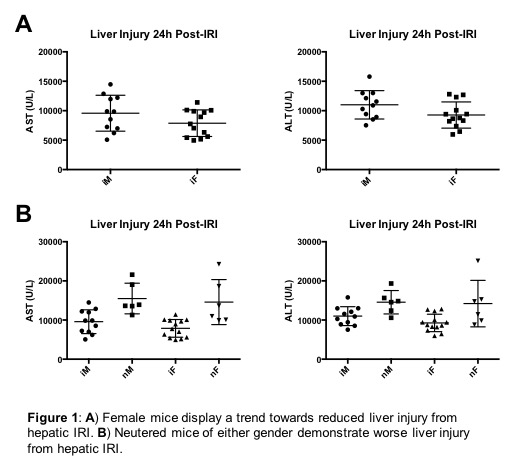Neutering Worsens Liver Ischemia/Reperfusion Injury in Both Male and Female Mice.
1Surgery, Hospital of the University of Pennsylvania, Philadelphia, PA
2Pathology and Laboratory Medicine, Children's Hospital of Philadelphia, Philadelphia, PA
Meeting: 2017 American Transplant Congress
Abstract number: A156
Keywords: Ischemia, Liver, Liver transplantation, Warm ischemia
Session Information
Session Name: Poster Session A: Ischemic Injury and Organ Preservation Session I
Session Type: Poster Session
Date: Saturday, April 29, 2017
Session Time: 5:30pm-7:30pm
 Presentation Time: 5:30pm-7:30pm
Presentation Time: 5:30pm-7:30pm
Location: Hall D1
Introduction: Ischemia/reperfusion injury (IRI) causes significant morbidity in liver transplantation and other surgical scenarios. A better understanding of the molecular mechanisms of IRI is required so that strategies for prevention and treatment can be developed. We have previously shown that tolerance of renal IRI is profoundly increased in female mice compared with male mice and that neutering of either sex creates an intermediate phenotype. We wished to investigate whether similar gender dichotomies exist in hepatic IRI.
Methods: 8-12 week old C57BL/6 hormonally intact male (iM) and female (iF) mice were subjected to 70% liver ischemia for 60 minutes under strict temperature control. Plasma concentrations of AST and ALT were assessed at 24 hours post-injury, and liver tissue was harvested for histopathology at 48 hours post-injury. Male (nM) and female (nF) mice were neutered at 3 weeks of age and subjected to liver IRI at 8-12 weeks of age using the same IRI model.
Results: iF mice displayed a trend towards reduced liver injury after hepatic IRI compared to iM mice as measured by serum AST (p=0.14) and ALT (p=0.08) (Figure 1A). Neutered mice of either gender displayed increased liver injury compared to hormonally intact mice of their respective gender (p<0.05) (Figure 1B). Conclusion: Neutering mice of either gender leads to impaired recovery from hepatic IRI. These findings are distinct from patterns observed in setting of renal IRI, suggesting tissue-specific injury pathways. This implies that IRI is not monomorphic, which has implications for therapeutic intervention. The augmented injury observed with neutering of both genders suggests that a wide range of hormonal therapies with either estrogen or testosterone, or both, may be useful in the mitigation of this process.
Conclusion: Neutering mice of either gender leads to impaired recovery from hepatic IRI. These findings are distinct from patterns observed in setting of renal IRI, suggesting tissue-specific injury pathways. This implies that IRI is not monomorphic, which has implications for therapeutic intervention. The augmented injury observed with neutering of both genders suggests that a wide range of hormonal therapies with either estrogen or testosterone, or both, may be useful in the mitigation of this process.
CITATION INFORMATION: Murken D, Aufhauser Jr D, Concors S, Wang Z, Ge G, Hancock W, Levine M. Neutering Worsens Liver Ischemia/Reperfusion Injury in Both Male and Female Mice. Am J Transplant. 2017;17 (suppl 3).
To cite this abstract in AMA style:
Murken D, Jr DAufhauser, Concors S, Wang Z, Ge G, Hancock W, Levine M. Neutering Worsens Liver Ischemia/Reperfusion Injury in Both Male and Female Mice. [abstract]. Am J Transplant. 2017; 17 (suppl 3). https://atcmeetingabstracts.com/abstract/neutering-worsens-liver-ischemiareperfusion-injury-in-both-male-and-female-mice/. Accessed December 14, 2025.« Back to 2017 American Transplant Congress
